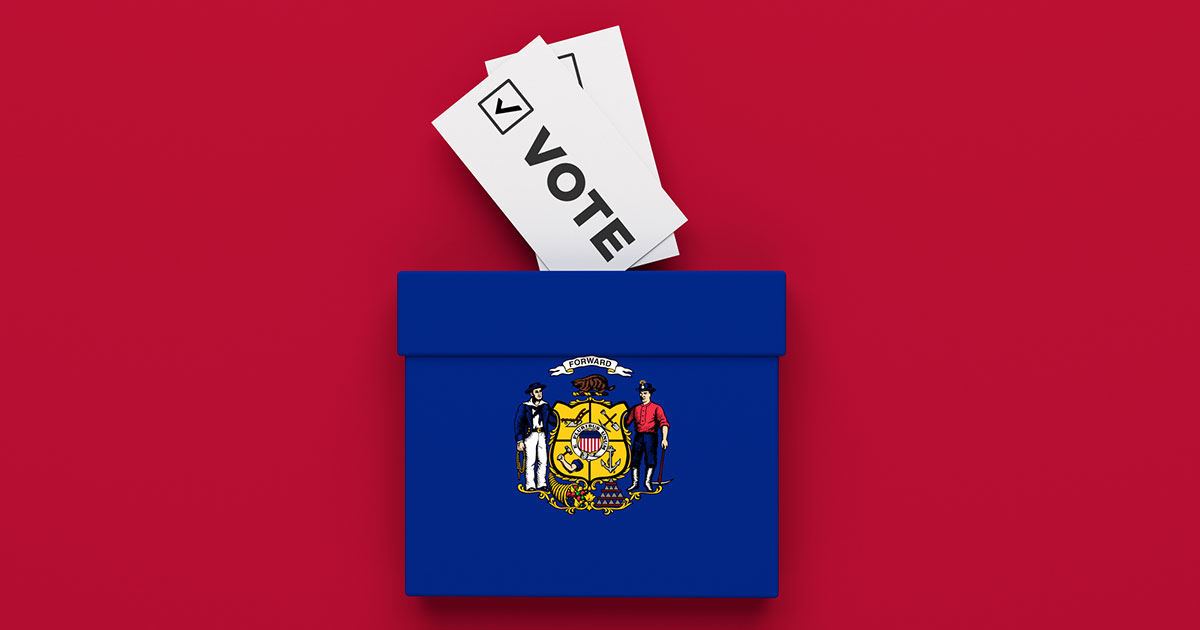
Nov. 26, 2025 – An idea currently being litigated in Dane County Circuit Court would return Wisconsin voting to what it was when the state began, offering, its proponents claim, a political party for all voters.
That promise is fusion voting, outlawed by
1897 Wis. Act 348.
“We need to have our parties to be actually at their hustle,” said Beau Tremitiere. “We need our parties to be real associations, and that … work … to go into communities and to go and connect with people and to be more than just a PR firm.”
Tremitiere, counsel at the nonpartisan nonprofit Protect Democracy, participated in one of four panel discussions on the topic, “Parties, Power and Possibility: Revisiting Fusion Voting in Wisconsin” on Nov. 14 at U.W.-Madison.
Sponsors for the day-long event included the U.W. Law School, the Tommy G. Thompson Center on Public Leadership, the Elections Research Center at U.W.-Madison, the State Democracy Research Initiative, New America, and the Center for Ballot Freedom.
The proposal hinges on
United Wisconsin v. Wisconsin Elections Commission, No. 2025CV1438, which claims the limitation of one political party nomination per candidate, currently codified at Wis. Stat.
section 8.03(1), is unconstitutional.
United Wisconsin, which seeks to become a fusion party furthering centrist candidates, filed the lawsuit on April 28. The case has a scheduled discovery deadline of March 9, 2026.
Courts in Kansas and New Jersey face similar lawsuits.
Fusion Voting and Wisconsin’s Founders
Fusion voting means a political party may “nominate a candidate that is already nominated by another political party,” said Dave Palmer, campaigns director and counsel for the nonpartisan nonprofit Center for Ballot Freedom.
 Jay D. Jerde, Mitchell Hamline 2006, is a legal writer for the State Bar of Wisconsin, Madison. He can be reached by
email or by phone at (608) 250-6126.
Jay D. Jerde, Mitchell Hamline 2006, is a legal writer for the State Bar of Wisconsin, Madison. He can be reached by
email or by phone at (608) 250-6126.
This possibility allows a minor party or a third party to nominate a candidate who has a major party nomination, Palmer explained.
Wisconsin’s first proposed state constitution “was born out of a fair and representative cross-party coalition of Democrats and Whigs,” said Allie Morris, a U.W.-Madison doctoral student in history.
Likewise, the Republican Party, when it was being created at Ripon, came out of a fusion of Abolitionists, Whigs, and Free-Soilers.
The historic names document the transitory nature of such third parties, which in Wisconsin also included the Reform Party, the Silver Party, the Greenback Party, the Temperance Party, and the Populist Party, Morris said.
These short-lived parties, Morris said, “had significant electoral impact.”
Every state permitted fusion voting at some time more than 100 years ago, Palmer said. Now only New York and Connecticut allow it.
The 1897 legislation that banned fusion voting in Wisconsin came from Republicans seeking protection from fusion parties, Morris said. The law reduced competition.
Other states did the same. In North Carolina, Democrats stopped fusion voting in the 1890s after losing to African American Republicans and the Populist Party of poor farmers, explained Andy Craig, fellow at the Rainey Center, a public policy research organization in Washington, D.C.
“The history of how fusion was banned, state by state, was almost always an ugly story of a political party abusing its control over the government-printed ballot to enact what is fundamentally a policy of censorship,” Craig said.
‘Inherent in Our Own History’
“We're not trying to create something in a lab and introduce it into the American system,” Tremitiere explained. “It's really the reintroduction of something that had been inherent in our own history that it really makes possible what's latent in the electorate.
“It makes it possible for people who want to organize and who want to create and claim their own political power to do so in an effective way.”
Proponents argue that fusion voting allows more of the electorate – those who don’t feel like they fit in the Democratic and Republican parties – to find a party they believe in and express their vote meaningfully.
The expansion of political voices that can swing a major-party candidate’s election, proponents claim, offers the ability to reduce polarization, increase competitive races, and empower voters.
“I see fusion parties in some key instances as sort of providing the avenue for folks who are boxed out of that polarized two-party system,” said Jennifer Dresden, policy strategist at Protect Democracy, in analyzing the history of fusion voting.
Small, focused fusion parties, proponents say, are motivated to talk with voters.
“Fusion voting … encourages people who are starting these new parties to actually do some real organizing, to actually show up and be in places and mobilize voters,” said Lee Drutman, senior fellow in the Political Reform Program at New America in Washington, D.C.
“Right now, our parties, the two, the dominant parties, don't do any organizing,” said Lisa Disch, professor at the University of Michigan, Ann Arbor.
“They ask for your money, and they run television ads. And they make people dislike politics intensely, or hate it.”
In New York, fusion voting has encouraged a working relationship between fusion parties and major parties – and the fusion parties provide a means to hold the major parties accountable, said Derek Muller, professor at Notre Dame (Ind.) Law School.
Craig agreed that in New York, “because you can have the left and right parties engage more productively, you can also end up with less polarized major parties.”
At minimum, said Dan Cantor, co-founder of the Working Families Party, a fusion party in New York, “it’s going to produce more accurate representation, left, right, and center.”
Nothing Inherently Centrist
There’s nothing inherently centrist to fusion voting, Muller said. “Minor parties could arise that support … hard-right Republicans or socialist labor candidates or uncompromising progressives.”
New York’s fusion voting experience supported such concerns.
New York’s “minor parties tend to be at the ideological extremes,” said Daniel Lee, associate professor at the University of Nevada, Las Vegas.
“We have not seen a center party emerge in New York,” said Nathan Atkinson, assistant professor at the U.W. Law School. “There's no depolarizing party in New York.”
Politics can lead to fusion party nominations for reasons other than the candidate's qualifications.
New York Gov. Kathy Hochul, a Democrat, endorsed New York City mayoral candidate Zohran Mamdani, said Daniel DiSalvo, professor and associate dean at the University of North Carolina at Chapel Hill, “which has been widely interpreted as a preemptive move to prevent … a candidate to her left in next year’s gubernatorial race.”
Fusion party nominations may result from “backroom deals” that result in a “perversion of voter will,” said Peter LaVenia, assistant professor at State University of New York (SUNY) Oneonta.
The fusion candidates that result may not share the party’s values, LaVenia said.
Major parties, protecting their interests, also could counter fusion voting with “tighter nomination rules” or “certain kinds of loyalty pledges,” Muller continued. Such new limitations could harm existing third parties like the Green and Libertarian parties.
“Smaller parties also tend to do better in states without fusion,” said LaVenia, who also is co-chair of the Green Party of New York.
LaVenia showed that a candidate can appear four times on the New York fusion ballot. Parties, like the Greens, that don’t nominate major party candidates get pushed to the bottom of the ballot.
“I think [the ballot is] very ugly,” LaVenia said.
‘Reimagining Politics in Wisconsin’
“I don’t see a place for me in either of the major parties, at least for someone with my political views and my values,” said retired Wisconsin Court of Appeals judge and former Republican Assembly Rep. David G. Deininger.
Deininger is one of the plaintiffs in the United Wisconsin case.
“The current Republican party has left me, and actually, if I tried to go back, they probably wouldn’t have me. … Now, I can relate to some moderate Democrats, but it’s hard to fathom what the Democratic Party really stands for today,” Deininger said.
“When I go into the booth today to vote,” Deininger said, “it’s a quandary at times because I’m not crazy about either of the major party candidates.”
Under fusion voting, United Wisconsin may offer a choice for political moderates who are uncomfortable with existing options, Deininger explained.
Former Wisconsin Senate Majority Leader Dale Schultz, a Republican who is United Wisconsin co-chair and a plaintiff, sees people who are “increasingly desperate.”
“They don’t know where the food is going to come from for their family,” Schultz explained. “They’re worried about their healthcare, the cost of their healthcare.”
“Somebody has to talk to these people and convince them they’re not alone.”
“Somebody has to talk to them and tell them that there are people who care about them, who want to help them, and that they know their lives will be better if they reach out to their neighbor and lift them up,” Schultz said.
Fusion voting, Schultz said, offers people “a chance to sit at the table, to be a part of the discussions that matter to them” – to give them “an opportunity for agency.”
If United Wisconsin wins its case, the statutory prohibition on nominations from more than one party would be declared unconstitutional, Deininger explained.
Although some rules may need to be made – and panel participants pointed out those rules would determine the success of fusion voting – the court decision itself would authorize the practice, Deininger said.
“I strongly believe,” Deininger said, “that it’s wrong and arguably unconstitutional for the state of Wisconsin to tell me who I can or cannot associate with in the political arena.”
